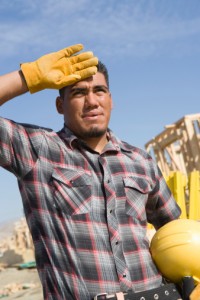Don’t Let Heat Stress Hurt You or Your Coworkers
 It’s summertime, which means temperatures are going to be skyrocketing here at KSB — and not just outdoors. It’s important that every employee be aware of how to prevent, identify, and treat heat-related illnesses in order to keep everyone safe and healthy during this scorching season.
It’s summertime, which means temperatures are going to be skyrocketing here at KSB — and not just outdoors. It’s important that every employee be aware of how to prevent, identify, and treat heat-related illnesses in order to keep everyone safe and healthy during this scorching season.
Why does it matter? Although heat stress can be fairly mild, it can lead quickly to heat exhaustion and even heat stroke, which is much more serious. Heat stroke can cause death or permanent disability if not treated.
Causes and symptoms of heat stress
What are the sources of heat stress? Any of these conditions can cause heat-related illness:
- High temperature and humidity
- Direct sun exposure
- No breeze or wind
- Low liquid intake
- Heavy physical labor
- Waterproof clothing (prevents sweating)
- Lack of recent exposure to hot workplaces
[sidebar]Don’t Skip the PPE — Even in the Heat
When temperatures are on the rise, the last thing you want to do is layer on personal protective equipment (PPE). But bypassing PPE is not worth the risk. Rather than skip the PPE, drink more cool fluids, take more breaks, and cool off faster by removing PPE when you take a rest break.[/sidebar]
How can you recognize heat stress? Look for these signs:
- Headache, dizziness, or fainting
- Weakness and wet skin
- Irritability or confusion
- Thirst, nausea, or vomiting
The most severe form of heat stress is heat stroke. A person who has heat stroke
- may pass out, collapse, have seizures, or be confused or unable to think clearly,
- may stop sweating, or
- may have a high body temperature (over 103 F).
Preventing heat stress
To prevent heat stress, you can start by knowing the signs and symptoms of heat illnesses and monitor yourself and your coworkers for signs of heat stress. Next, create shade and block out as much direct sun and as many other heat sources as possible. Drink plenty of fluids and drink often, at least every 15 minutes. You need to make sure you drink before you are thirsty, and avoid beverages containing alcohol or caffeine. Finally, when possible, wear lightweight, light-colored, loose-fitting clothes.
How do you treat heat stress? You need to take action as soon as you or a coworker shows signs of heat illness:
- Call a supervisor for help.
- Stay with the worker until help arrives.
- Move the worker to a shaded or cool area.
- Remove outer clothing.
- Fan and mist the worker with water; apply ice.
- Give the worker cool drinking water.
However, if the worker seems to be exhibiting signs of heat stroke (for example, he or she is not alert or seems confused), call 911 immediately. Heat stroke can be life-threatening if it isn’t treated quickly.

